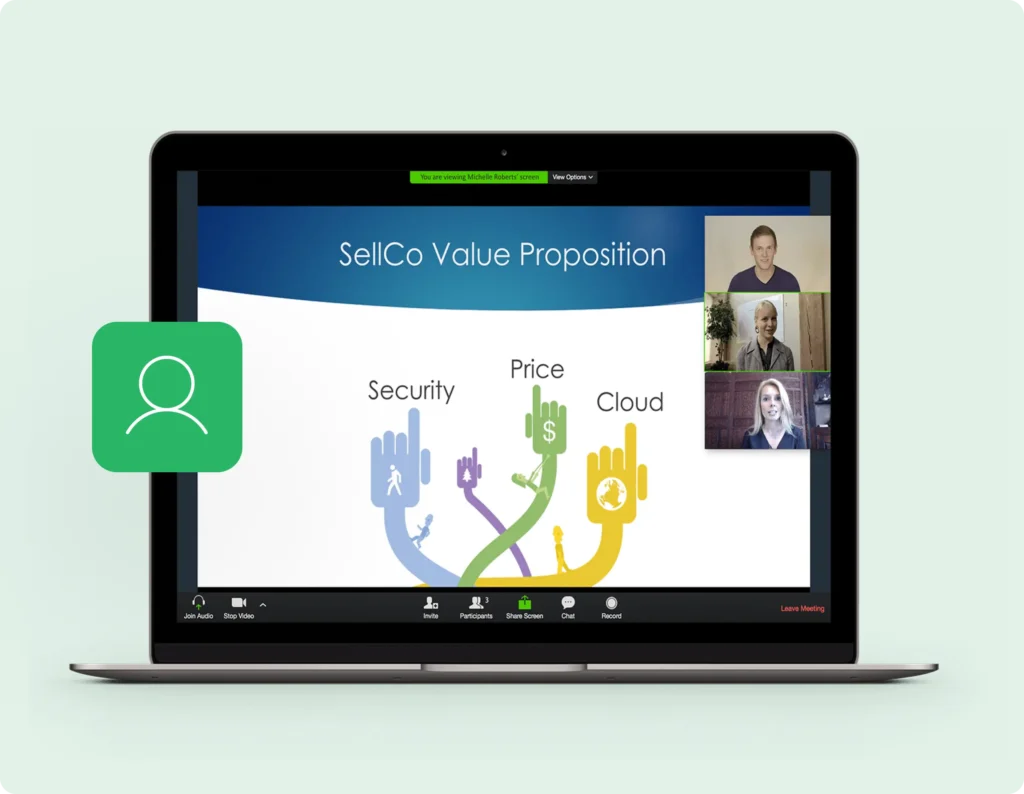- Communications
Best Practices For More Effective Interactive Sales Presentations

With enormous amounts of information available at their fingertips, today’s prospective customers are savvier than ever. The people who could benefit most from your solutions, from the top decision-makers to individual knowledge workers, have grown skilled at tuning out most sales pitches using interactive sales presentations.
As today’s sales reps know all too well, it’s more challenging than ever to deliver a compelling story about your solution and ensure it leaves a lasting impression. And that’s true just when you’re across the table from your audience—when presenting remotely via video conference, which is more often the case, the task of making a message stick borders on outright impossible.
That is if you’re delivering your sales presentations the same way everyone else is.
First impressions count, and when time and attention spans are limited, how you say something often matters just as much as what you’re actually saying. So how do you make sure your online video presentation stands out?
Follow these five best practices for delivering more effective sales presentations through video, which will help you engage your audience and ensure your pitch won’t be forgotten.
1. Make sure prospects can see you and your presentation
Your slide deck doesn’t sell your solution; you do. So why do so many reps present slides with a voiceover to prospective clients?
When you can’t present your pitch in person, showing a video of both you and your slides or you and a screen share is the next best thing to presenting live. Most video conferencing solutions will allow you to show your screen and a video of yourself at the same time. So be sure to share your webcam video and the presentation on your screen.
This type of video sales presentation enables you to reinforce the messages you want to highlight and helps ensure prospects are engaged throughout the presentation.
A video presentation that shows more than just your slides may even bolster your win rate. Studies have shown that including a presenter in a recorded presentation helps humanize the delivery, enabling you to use the 90 percent of human communication that is non-verbal. And it helps your prospects, too—eye contact makes your words more memorable, so they’re more likely to retain the information you presented.

Today’s prospects are better informed than ever. A few moments on Google will teach them most of what they need to know about your company, your product, your market, and even you. And that’s important, as today’s prospects are also busier than ever and typically prefer to save time and skip right to the brass tacks.
So why do so many reps spend the first 10-15 minutes explaining the basics of their company and its offerings?
Make your prospects happy by saving them time. Steal a page from Amazon, LinkedIn, (and in all likelihood, your own Learning & Development team) and flip your meeting instead.
Here’s how it works: In a flipped meeting, you record a short video presentation covering all the basics prior to your meeting, then send it to your prospect and ask that they view it before your call. That way, you can spend your actual meeting time diving deeper into the solutions that are most interesting to your prospect, and you’ll have more time to answer her questions.
The best way to record and share your video presentation for a flipped meeting is with a free video screen recorder like Panopto Express. Capture video of you presenting, your slides, and even a demonstration on your screen, then show them all side-by-side.
3. Make your sales presentations interactive
If you want your sale to succeed, you don’t want your audience leaning back in their chairs passively listening. You want them leaning in, asking questions, and interacting with you.
Countless “best practices” speak to the importance of tailoring the content of your presentation to a prospective customer’s specific needs. But when presenting to a new prospect, you may not yet know what those needs are. Planning an interactive presentation not only engages your prospect in the meeting but also enables you to adjust the content of your presentation to show them the solutions you can provide that will help them the most.
By simply asking questions in your presentation that steer you towards their biggest pain points, you can personalize your pitch to your prospect’s responses and hold their attention throughout the entire meeting.
4. Stop sending your slides
There’s a big problem with sending your slides after your interactive sales presentation is over, or even before the meeting. They don’t include the most important part of the presentation — you. Without someone to present them, even the best slide decks are flat and listless, not to mention prone to misunderstandings and misinterpretations.
Recording your live sales presentation as it happens and sharing that video with your prospect after the meeting ends gives her the ability to revisit everything you showed her and even share the presentation with her colleagues. It’s also a smart strategy for getting your presentation in front of busy decision-makers who may not have been able to attend the live meeting because of a scheduling conflict or a higher priority project.
Simply press record at the start of your presentation in your video conferencing software. You can share the large downloadable video file it produces with your prospect, or better yet, integrate your video conferencing software with a video platform like Panopto that makes sharing a private video as easy as sharing a link. With an integrated video platform, your video conference recordings can be automatically uploaded to your secure video library. Then, when you share the video with your prospect, they can simply click the link and stream your video from any device without having to download the entire file or special software to play it.
5. Record and share a follow-up video
There are a number of reasons you would want to send a prospect a follow-up video to keep them engaged in the sales process. Here are a few scenarios in which you would benefit from sending a short follow-up video presentation with new information:
- They wanted more information about something specific and you needed to track down the answers after the initial presentation.
- You ran out of time on the call to show them everything because the prospect was highly engaged in one particular solution.
- They haven’t engaged recently and you want to grab their attention.
Watch an example of a follow-up sales presentation video recorded with Panopto:



